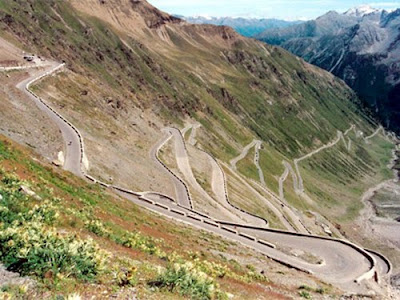1: Hana Highway
Maui, Hawaii
Background: Hawaii's Hana Highway runs along the northeast coast of Maui, and is constantly cited as one of the world's most scenic drives.
How It's Unique: The Hana Highway takes drivers around 600 curves and over 54 bridges (most of which are one-way) in just 52 miles. "Whenever you have to build a road like this in a coastal area, your best bet is to hug the terrain," says Hani Mahmassani, a civil engineer who has led more than 100 transportation projects and is the director of Northwestern University's Transportation Center. "If you wanted to put something faster-running through this area, you would have to cut through the rock or put in a tunnel, which is very expensive." The road's winding design, narrow passages and stunning views take some slow-going motorists as long as 4 hours to navigate, according to Hawaii's Visitors and Conventions Bureau.
2: Passo dello Stelvio
Lombardy, Italy
Background: This mountain pass in the Italian Alps starts an elevation of 3116 feet and ascends to just under 9050 feet, or 1.7 miles above sea level. The pass was first constructed in 1820.
How It's Unique: The Stelvio Pass has a dizzying 48 hairpin turns and an average grade of 7.4 percent. "To go down that slope, you either basically cut down the mountain to remove that slope, or you have to go back and forth and zigzag a lot," Mahmassani says. The road, which hosts one of the more gruelling stages of the Giro d'Italia bicycle race, has a 7.4 percent grade--"huge" by American standards, Mahmassani says. Six percent grades are about the maximum for U.S. highways, he says, and require escape lanes and safety signage. "You go down or up this road, you're going to get seasick," he says.
3: Guoliang Tunnel
Hunan, China
Background: This spectacular tunnel is one of the few ways to travel to the remote Guoliang village in China's Hunan Province.
How It's Unique: Chiseled by hand in the 1970s, the Guoliang Tunnel is a road that Mahmassani calls "a sculpture more than a means of transportation." The tunnel passes through a treacherous section of the Taihang Mountains and is lined with makeshift windows that provide scenic but terrifying views. With a clearance of only 15 feet, a width of 12 feet and a precipice around every other bend, navigating this short tunnel is a guaranteed thrill.
4: Monumental Axis
Brasilia, Brazil
Background: This massive expressway runs southeast and northwest through the heart of Brasilia, providing access to some of the country's most important government, financial and cultural institutions.
How It's Unique: Brazil's capital city, Brasilia, was built in the late 1950s, allowing engineers and architects to incorporate large, urban-friendly structures into the highways, which were an important part of the city planning. The open space in the center of the higway, which some claim is the world's largest median, divides the twelve total lanes of eastbound and westbound avenues. Mahmassani likens the structure to the National Mall in Washington, D.C. "You have a lot of green space where you can do activities and people can go for big events, like presidential inaugurations."
5: The Atlanterhavsveien
Møre og Romsdal, Norway
Background: Atlanterhavsveien, better known as the Atlantic Road, is a 5.4-mile stretch of road on Norway's west coast that opened in 1989.
How It's Unique: The Atlantic Road consists of eight small bridges that cross over an archipelago of eight different islands. "This is a beautifully done road and it opens up the [scenery]," Mahmassani says, pointing out the way in which it follows the natural terrain of the small islands. Norway's Ministry of Foreign Affairs notes that the region where the road is situated is prone to autumn hurricanes, and its website says that construction teams had to withstand a dozen hurricanes while building the road.
6: The Magic Roundabout
Swindon, England
Background: This juggernaut of a junction opened in 1972. It was originally called County Islands Ring Junction, but later was officially named The Magic Roundabout, a reference to a 1960s-era European television show for children.
How It's Unique: England is notorious for littering its streets with roundabouts, but Swindon's Magic Roundabout is one of the most complex rotaries in the world. Five smaller roundabouts direct traffic clockwise while cars travel counterclockwise around the inner circle. "We don't recommend a design like this at all," Mahmassani says. "It's very, very confusing and dangerous, but there are people in England who like to design these things." Ray Harper, one of the engineers behind the concept, told the BBC that in its first years the design allowed for 1100 more cars to pass through per hour.
7: Highway 1
Iceland
Background: Iceland's Highway 1 was completed in 1974 and is roughly 830 miles long.
How It's Unique: Highway 1 is better known as the Ring Road, because it forms a giant loop that circles the whole of Iceland. Much of the road has only one lane heading in each direction as it dices through fjords, cuts across the country's sub-Arctic desert and curves along the Atlantic coastline. The Ring Road is especially tourist-friendly, hitting most of the major Icelandic landmarks, though drivers should be prepared for unpaved stretches and antiquated bridges.
8: The Cherohala Skyway
Robbinsville, N.C.
Background: This byway runs through the Great Smoky Mountains of southwestern North Carolina before taking drivers down through Tennessee's dense wilderness.
How It's Unique: Although the Cherohala Skyway is only about 50 miles long, it came with a price tag of more than $100 million and was in planning for about 36 years. The two-lane road officially opened in 1996, with elevations ranging from 900 feet above seal level in Tennessee to 5,400 feet above sea level at Haw Knob, a mountain summit that serves as the border between the two states. Deemed a National Scenic Byway by the Federal Highway Administration, the Cherohala Skyway is arguably one of the most scenic stretches east of the Mississippi.
9: Yungas Road
La Paz, Bolivia
Background: Don't expect to find guardrails while traveling along the Yungas Road from La Paz to Coroico in western Bolivia. The road ranges in elevation from 4000 feet to more than 15,000 feet and is as narrow as 10 feet in some sections.
How It's Unique: This notorious road has earned the nickname Road of Death, thanks to the countless accidents that have occurred on it. Two-thousand-foot drops are not uncommon as the Yungas snakes through Bolivia's wilderness. "The history of these things, typically, is that you have a trail, like a donkey trail, that becomes the road," Mahmassani tells PM. "It's essentially the path of least resistance." Widening this road would be a massive project, both environmentally and financially, that would involve cutting and removing tons of mountainside.
10: Dalton Highway
Livengood, Alaska
Background: This highway was built in the 1970s to run parallel to the trans-Alaskan pipeline. It runs from Livengood, Alaska, toward the Prudhoe Bay oil fields.
How It's Unique: The Dalton Highway makes the cut because of its extreme remoteness and desolate design. Nearly all of the 414 miles of the road are unpaved, loose stretches of gravel. The Bureau of Land Management cautions potential drivers that, "you'll see no restaurants, no gift shops, no service stations--just forest, tundra and mountains, crossed by a double ribbon of road and pipe." If the road was paved, Mahmassani says, maintaining it would be a nightmare--and Alaska's cold climate would riddle it with potholes. Also, gravel provides more friction for vehicles making the trek in inclement weather and doesn't ice over as easily as pavement.
11: Capulin Volcano Road
Capulin, N.M.
Background: This twisting road climbs Capulin Volcano, a defunct cinder cone in northeast New Mexico that erupted about 60,000 years ago and has a circumference of about 4 miles at its base. The first road ascending this volcano was completed in 1925.
How It's Unique: The 2-mile-long Capulin Volcano Road is so narrow and sinuous that all traffic must be stopped when a bus is traveling up or down the volcano. Guardrails are missing through most of the route, except on the tight S-curves, and the road has a 6 percent grade. After travelers summit the volcano, which has a peak elevation of 8182 feet, they can follow hiking trails down into the crater.

12: Karakoram Highway
Gilgit-Baltistan, Pakistan
Background: This 800-mile-long highway links Pakistan and China. The two countries agreed to its construction in 1966, and construction continued through 1978. It took until 1986 for all of the border crossings to officially open.
How It's Unique: Building a road through one mountain pass is a daunting task, and this highway passes through the Himalaya, Karakoram and Pamir mountain ranges, reaching 3 miles above sea level at certain points. "Usually in these situations, anytime you have mountains you want to go through, you have to follow the passes," Mahmassani says. The danger of the mountain passes was all too clear during the course of the road's construction, when 810 Pakistani and 82 Chinese workers were killed.

13: Avenida 9 de Julio
Buenos Aires, Argentina
Background: This huge north-south avenue officially opened in October 1937, but it was still being expanded through the 1980s. The road, modeled after France's Champs-Élysées, is one of the broadest avenues in the world.
How It's Unique: At the avenue's widest points, eight lanes of traffic run in each direction, and both sides of the road are flanked by smaller streets that carry two or more lanes of additional traffic. The total width of the road, when combined with the side streets, is just shy of 460 feet. While wider highways might seem like a potential solution to increased traffic in cities, Mahmassani points out that building them is usually not a feasible option. "You would be dealing with such expensive real estate, for one" he says. "Unless you had the foresight of Napoleon to give you the Champs-Elysées, you're just not going to have something like this."

14: Trollstigen
Rauma, Norway
Background: This mountain pass in southwest Norway opened in 1936 after eight years of construction. Trollstigen aptly translates from Norwegian to English as "Troll Ladder."
How It's Unique: Eleven hairpin turns take drivers 2800 feet above sea level with an average grade of 9 percent. This scenic road is accented by the Stigfossen waterfall, which runs down the side of the mountain and is crossed by a small bridge on the way toward the road's apex. Sections of the pass were cut directly into the face of the mountain during the 1930s. The pass tends to open in late May and sometimes closes through June because of the region's harsh winters.

15: Canton Avenue
Pittsburgh, Penn.
Background: This small cobblestone side street can be found in Pittsburgh's Beechview neighborhood."
How It's Unique: Pittsburgh's Department of Public Works confirms that this short road has a 37 percent grade, which means that it ascends 37 feet in elevation for every 100 horizontal feet it travels. Fortunately, for pedestrians, city planners included a flight of steps along the side of the road. "You wouldn't specify this road as a modern design; these usually exist for historical reasons," Mahmassani says. Canton Avenue has an ongoing feud with New Zealand's Baldwin Street (which unconfirmed reports claim has a grade anywhere between 35 and 38 percent) for being the world's steepest drivable street.

16: The High Five Interchange
Dallas, Texas
Background: This five-level marvel of engineering can be found on the outskirts of Dallas, where Interstate 635 connects with U.S. 75. Construction crews, despite the project's enormous scope, were able to complete the labyrinth of lanes in December 2005, a full year ahead of schedule.
How It's Unique: As Mahmassani points out, building wider roads is just not feasible in most cities. The solution for Dallas? Go vertical. Certain points of the High Five are as tall as a 12-story building, and about 500,000 commuters pass through it daily. The project required 37 permanent bridges and six temporary bridges to be built. Additionally, 300,000 square feet of retaining wall and 74,000 square feet of drainage pipe run along the interchange. In 2006, the American Public Works Association selected the interchange as one of its "Public Works Projects of the Year."

17. Lombard Street
San Francisco, Calif.
Background: This curvy block is an American icon that attracts tourists from around the world. Hundreds of hydrangeas and flawlessly groomed shrubs bring a vibrant look to the road that is rarely found on city streets.
How It's Unique: San Francisco's most recognizable street originally had a 27 percent grade, making it too steep for the first automobiles to conquer. In 1922, the eight curves were added, reducing the grade to 16 percent. Lombard Street was a two-way road until 1939.

18: Tibbitt to Contwoyto Winter Road
Northwest Territories, Canada
Background: Made famous by the History Channel's Ice Road Truckers, this ice road is 370 miles long and is used to haul freight to Canada's bountiful diamond mines.
How It's Unique: The path from Tibbitt to Contwoyto isn't really a road; it's an interconnected collection of frozen lakes that form a trucking lane. As PM has previously reported, the route is meticulously planned along the thickest route and is monitored by maintenance crews who brave temperatures that can drop to minus 70.

[Source: http://www.popularmechanics.com]














2 Komentar:
terjal dan curam
HALO KANG
FADHIL666
SEMARANG ROOM ^_^
Posting Komentar
Saran dan Kritik bersifat membangun....
Gunakan kata-kata yang baik (berPendidikan)..
Makasi buat respon'nya Om/Tant ...
^^v